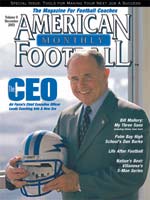AMERICAN FOOTBALL MONTHLY THE #1 RESOURCE FOR FOOTBALL COACHES
Article CategoriesAFM Magazine
|
Hired! Now What?Tools for Making Your Next Job a Successby: Aaron S. Lee © More from this issue Last month, American Football Monthly gathered a panel of experts to give you the tools you need to get your next job in part one of a two-part series focused on career management. AFM discussed everything from networking, resumes, interview skills, salary negotiations, coaching agents and dealing with the media. This month, AFM pulls out all the stops in part two as we show you what to do once you get that new job. AFM has once again invited some of the nationís best advisors, along with some of our big guns Ė thatís right, our AFM legends. Coaches like Grant Teaff, R.C. Slocum, Marv Levy and Don Nehlen provide our readers with some of the key ingredients needed to....The full article can only be seen by subscribers. Subscribe today!
|
|
|||||||
| HOME |
MAGAZINE |
SUBSCRIBE | ONLINE COLUMNISTS | COACHING VIDEOS |
Copyright 2025, AmericanFootballMonthly.com
All Rights Reserved





